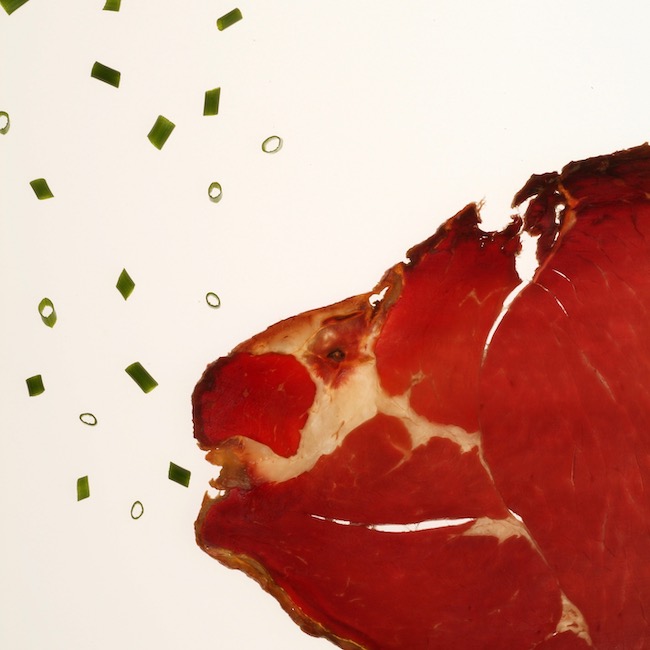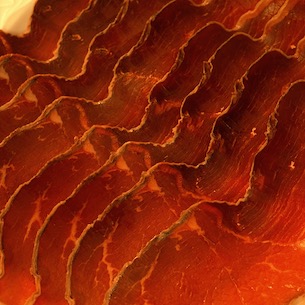.png.transform/rendition-xs/image_image%20(1).png)
Cecina, The Greatest Spanish Delicacy you’ve (probably) Never Tasted
Cecina remains one of the country's best kept secrets. Something which be about to change
Dry-curing meat is amongst the oldest forms of food preservation. This is especially the case in Spain, where all kinds of meat has traditionally been cured: pork, horse, goat, donkey, hare, rabbit... Standing alongside the very best Ibérico ham is Cecina de León: premium dry-cured beef.
Celts, Romans, Countrymen…
Evidence of dried beef has been found in excavations of ancient Celtic settlements in central Spain, and when the Romans arrived on the Peninsula, they discovered a thriving culture of meat curing, including beef. A millennium and a half later, in Don Quixote, the renowned glutton Sancho Panza boasts about his diet of ‘goat, cow, bacon, hung beef, turnips and onions’. And in the nineteenth century it was still a staple of the diet, with large quantities of cecina being sold at fairs and markets in the León area.
In fact, it’s in the province of León that we find the richest and most enduring artisanal tradition. In 1994 Cecina de León was awarded its own PGI (Protected Geographical Indication), the coveted Europe-wide recognition of excellence and unique historical-geographical provenance.
Land, history, weather
León is in central north-western Spain. And it’s the very specific terroir of the province which provides the ideal conditions for cecina. With mountains, valleys, and a bone-dry meseta, the conditions are perfect for curing meat: hot, arid summers and cold, cold winters. People have always cured meat here: animals are slaughtered in the late autumn, and the cured meat provides protein for the following twelve months.
In the case of León, history provides us with another (delicious) detail. The province is landlocked, and traditionally arrieros (mule drivers) transported fresh produce, particularly fish, down from Cantabria in the north. They had a secret weapon, too: smoke was used to preserve their cargos on the long, slow trip back home. Not surprisingly, the same preservation method was used in farmhouses to extend the life of home-cured beef. And what started out as a practical necessity has become one of cecina’s defining characteristics.
Quality and tradition
Marta Fernández, from the company Embutidos Ezequiel, notes that the essence of their business is very clear: “conserving tradition since 1945”. It’s a pretty good way of summing up the whole production process. Since gaining PGI status, Cecina de León has become highly regulated, but never abandoning its artisanal origins. Only four muscle groups from a cow’s hind quarters can be used, all prime cuts. Animals must be at least 5 years old and weight a minimum of 400 kilos. The cuts themselves have a fresh weight of between 3 and 5 kilos, a little less than hams at the same stage.
Salting in course sea salt is the first step, followed by washing in fresh water. The pieces are then dried for 4-6 weeks, when the infiltrated salt begins its work. Just like with hams, microflora now develop within the meat, driving processes of enzymatic hydrolysis, although we might prefer just to call it the ‘magic’ that makes Spanish cured meats so irresistible.
The next stage—smoke—is unique to cecina. 12-16 days’ gentle smoking in oak or holm oak imparts a unique flavour, which accompanies the meat through the following stage. Having been greased with pig or beef fat, the pieces are cured, using essentially the same method of regulated dry air as used for Spanish ham. 7 months is the minimum, with anything over 12 earning the label León IGP (PGI) Reserva.

Head-to-head: cecina vs jamón ibérico
So, why would you opt for Cecina de León instead of ibérico ham? First off, Cecina has a dark outer colour and no bone. It can be sliced like jamon by a cortador. However, due to the absence of bones, it can just as easily be sliced on a machine. This is often the case in bars and restaurants, where smaller cuts (carved from an entire piece) are often used for convenience. Either way, small, wafer-thin slices are the way to go.
It presents like ham, but has a richer colour, somewhere between cherry red and a deep toasted brown. Depending on the cut, you’ll get a light marbling of fat, but unlike ibérico, the fat is very subtle on the palate, and does not overpower the elegant, noble flavour of the cure, which is made all the more complex thanks to the background smoke. One might say that cecina constitutes a slightly ‘meatier’ experience than ham, packed with subtleties, in which fat plays a less prominent role. The presence of salt is very limited. This is not ‘salt beef’ in any way.
Mouthfeel is similar to ham, and in those cuts with less infiltrated fat, the finely sliced Cecina is often served with a dribble of olive oil. The texture is not fibrous, but smooth and surprising, and can have a satin-like feel. Accompanied with cheese, it packs an extremely elegant punch, its nutty notes drawing out the flavour of the cheese.
The health benefits of ibérico ham are well known, but cecina also has a lot of shout about: it’s rich in iron, calcium, potassium and phosphorus, and it’s a healthy, low-fat source of protein. It’s also infinitely flexible in the kitchen. Among the most frequent forms of presentation is as a carpaccio, dribbled with oil, and perhaps wall nuts. But in fact its rich, alluring flavour profile combines with a huge variety of things: fresh figs, truffles, asparagus, melon… on toast and pizzas, or finely chopped and sprinkled on salmorejo, pasta, salads.

The future
Of about 100,000 pieces of PGI Cecina de León sold annually by eleven officially recognised producers, only about 15% of which make their way abroad, largely to Europe. Londoners are well served: the premium reserva product is stocked by Harrods, sitting alongside some of the finest cured meats in the world (many of them from Spain).
But cecina might be about to take off globally, and the reason is, again, related to ham. Halal consumers are desperate for a premium Spanish cured meat that isn’t pork. This has not gone unnoticed in León, where the company Cecinas Nieto boasts the first 100% halal-certified cecina installation in the country. At 1,500m2, and with a production capacity of 350,000 kilos per year, it constitutes a huge step towards the internationalisation of Cecina. Sales to Morocco, Qatar, Kuwait and the UAE are growing, as the Muslim world embraces this alternative to Ibérico ham. Halal cecina is also increasingly consumed within Europe by the large Muslim populations there.
Just how far can cecina go? The world Muslim population is 2 billion. So, whereas it’s now common to find legs of ibérico on fine dining tables in China, Japan and the USA, it is not inconceivable that cecina will experience a similar boom over the coming years. As Conchi Nieto Martínez, from Cecinas Nieto, says, “…from León to the world!” It’s certainly food for rumination...
